PVC Pedal Launcher - RC Groups
I recently built a PVC (3/4") Pedal Launcher similar to The PVC Pedal Launcher that was featured in the September 2001 S&E modeler. It worked out great and was relatively inexpensive to build. It now has an approximate 15-degree incline (increased from 7.5 degrees in photo) and a 20-foot bungee providing the power. I have used it for Multiplex Picojet Combat, Multiplex Twinjet, and I plan to use it for a Kyosho T33 Shooting Star EDF.
On the launcher in the photo is a "Wallyworld" $3.94 special weighted with eight "D" cell batteries to approximate the launch weight of the Twinjet. The Launcher projected this flying test bed OK, but there was no radio control of the foam glider to prevent its demise on landing. Three test launches and the "Wallyworld" foam glider's fuselage gave its life for the cause. I sacrificed the test bed to save the flying aircraft.
Parts List for New PVC Pedal Launcher
I have listed the parts I used to build the 3/4" PVC Pedal Launcher. The launcher can be built to suit your application, but mine is 2' wide by 5' long to accommodate several planes.
- 3 @ 3/4" T connector
- 2 @ 3/4" X (four connection cross joiners)
- 5 @ 3/4" end caps
- 6 @ 3/4" 90's
- 4 @ 1" T's
- 4 @ 1" to 3/4" adapters
- 3 @ 10" 3/4" lengths of PVC
- 1 @ small can of PVC cement
- 2 @ 3/4" metal pipe brackets
- 1 @ 3/8" X 3" bolt (unthreaded for release pin)
- 2 @ 1" welded steel rings
- 3 feet nylon cord
- 10 feet foam pipe insulation
- 3 @ plastic tent stakes heavy duty
- 20 feet bungee or surgical tubing
I hope that these photos are helpful to those E-Zoners that may want to build a similar launcher, and now I will highlight some of the details of the PVC Pedal Launcher.
The bungee portion is not in the photo above. The 1" metal ring is attached to the plane to be launched. The nylon cord (white) is tied to the ring attached to the plane and tied to the 1" metal ring attached to the release pin. The bungee is also attached to the metal ring on the release pin. When you step on the pedal, the ring is forced off the release pin, and the tension provided by the stretched bungee is transferred to the plane through the nylon cord attached to the metal ring attached to the plane.
In the picture above, it is hard to see the nylon cord, but the metal ring with the red streamer attaches to the plane to be launched, and the other metal ring attaches to the release pin. The bungee also attaches to the metal ring on the release pin.
Bungee Stake Setup
Be sure to have a long, strong stake, and perhaps even a backup stake to prevent bungee releasing toward you. You can purchase 3/8" surgical tubing at home improvement stores such as Lowe's and some Home Depot stores as well.
You cannot hook the bungee directly to the plane because you won't have a "trigger" mechanism. The release pin holds the tension of the stretched bungee. The nylon cord transfers the power to the plane once you step on the pedal and release the bungee. I just got back from the field today and it works wonderfully. I could fly my plane in a small sized circuit and land if necessary, all without running the plane's motor.
The quick pull does no damage to the hook, because there is no slack in the cord or resistance to the plane's forward flight. Release the bungee and the plane takes off as if it were shot out of a gun.
The strength of the bungee can be regulated for the size and weight of the plane you are trying to launch. I use a fish scale and pull the bungee to a predetermined tension for different planes.
The pedal launcher is staked to ground (front & back), and the lead end of bungee is staked to ground after being stretched the correct tension. The other end of bungee is attached to release pin on pedal launcher. A nylon cord ties to bungee ring on release pin and attaches to hook on plane. When you step on pedal, it forces the tensioned bungee off the release pin and the tension shoots the plane up the launcher ramp and into the air. Applying a little up elevator raises the plane on release and ensures the bungee releases from the hook.
The ends of the bungee with metal "eyes" were attached by Hollyday Designs when I purchased the 20' bungee. The two ends cost $3.00 extra, if I remember correctly, and they attached them for free. I attach the eye end of the bungee to the stake using split (key) ring type connectors.
I hope this gives you the detail and the inspiration you need to go ahead and build your own PVC Pedal Launcher. You will be glad you did.
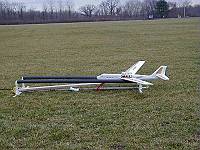
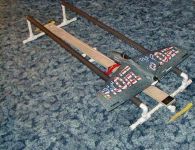
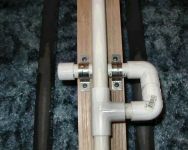
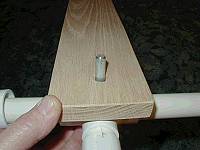
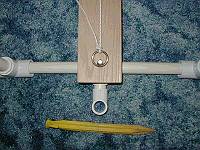
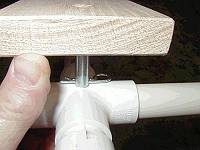
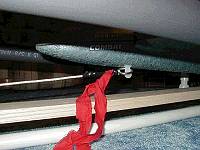
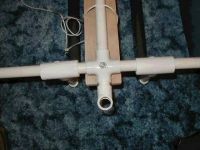
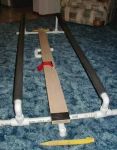
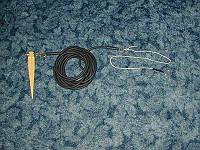
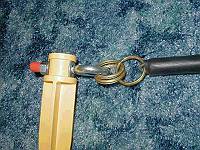
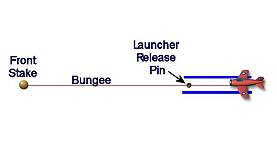
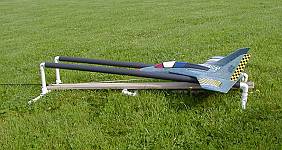
No comments:
Post a Comment